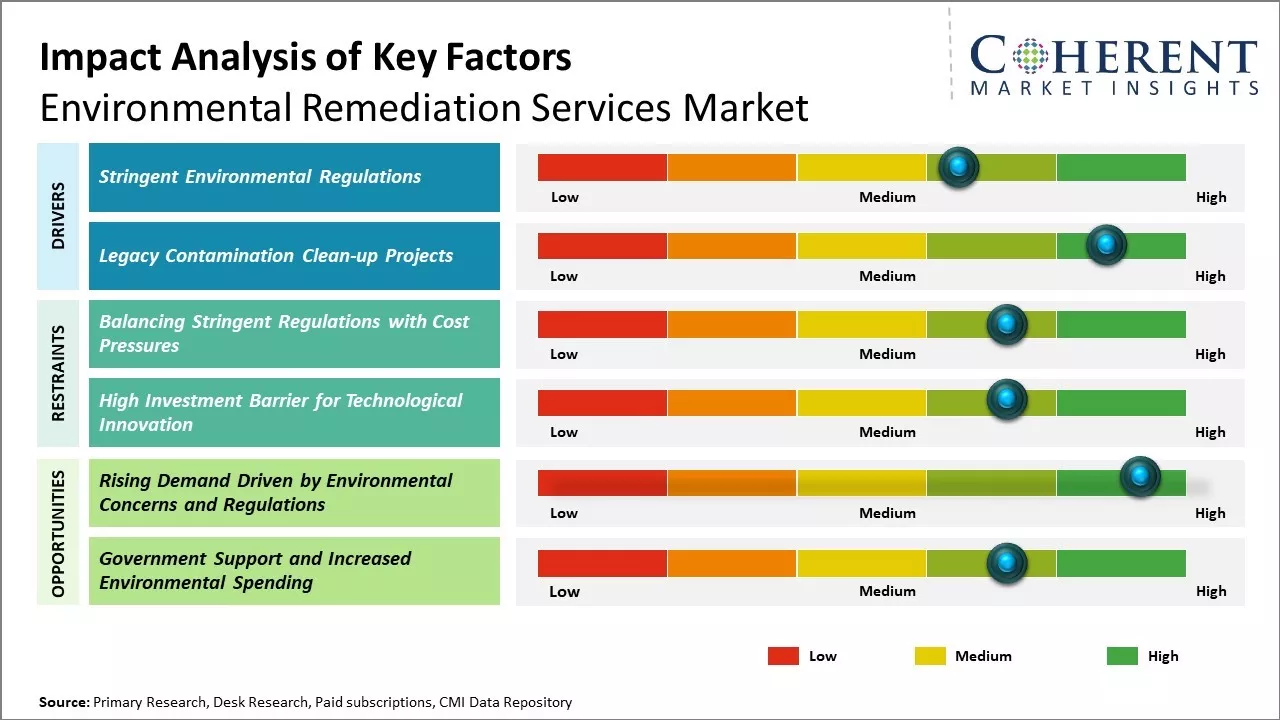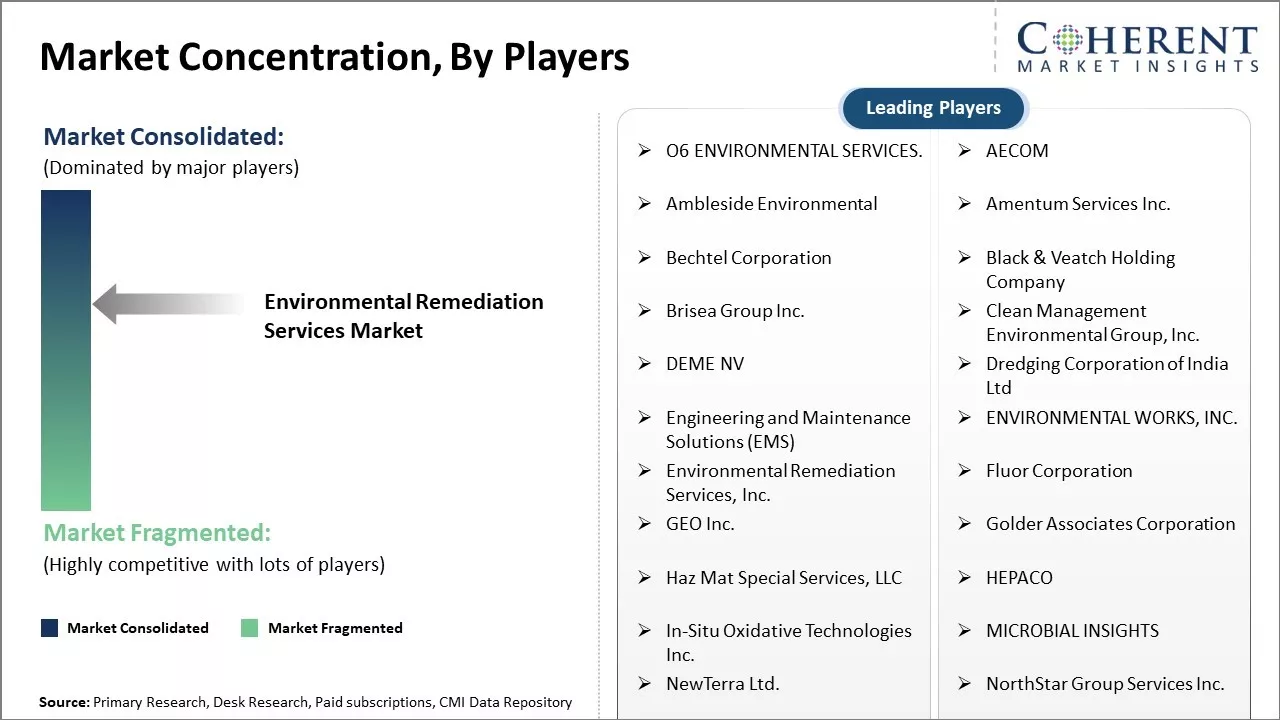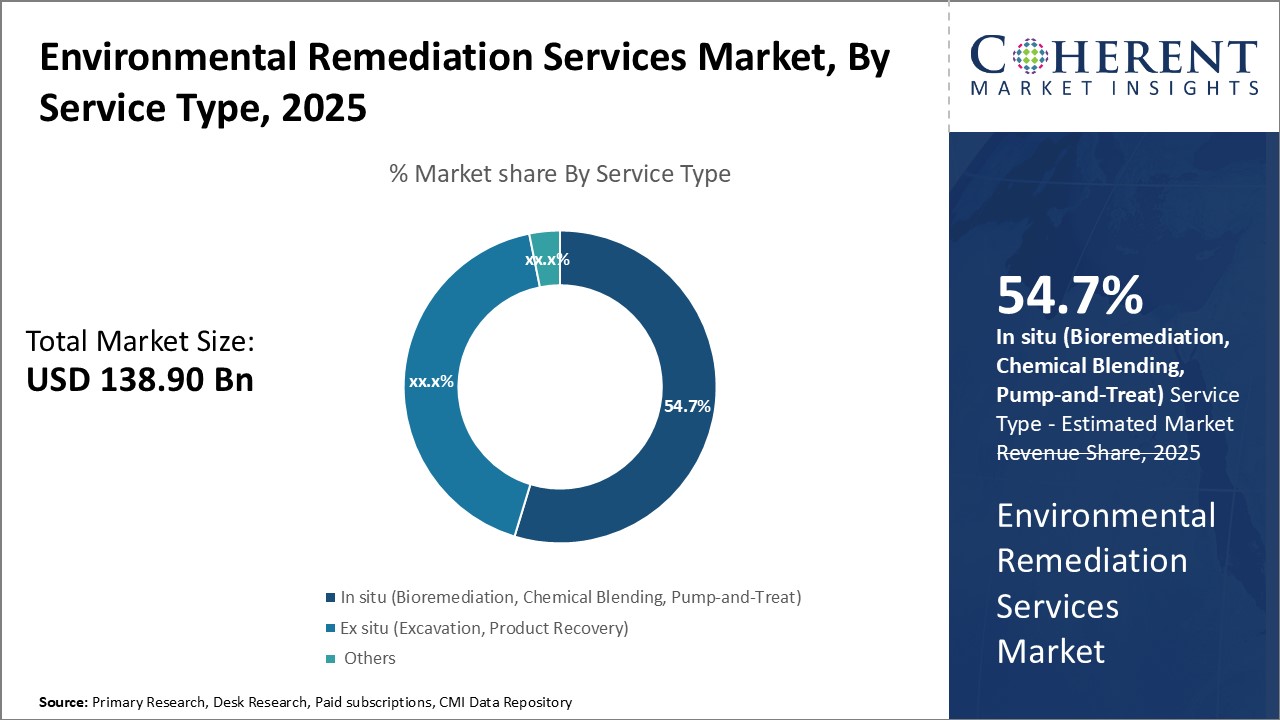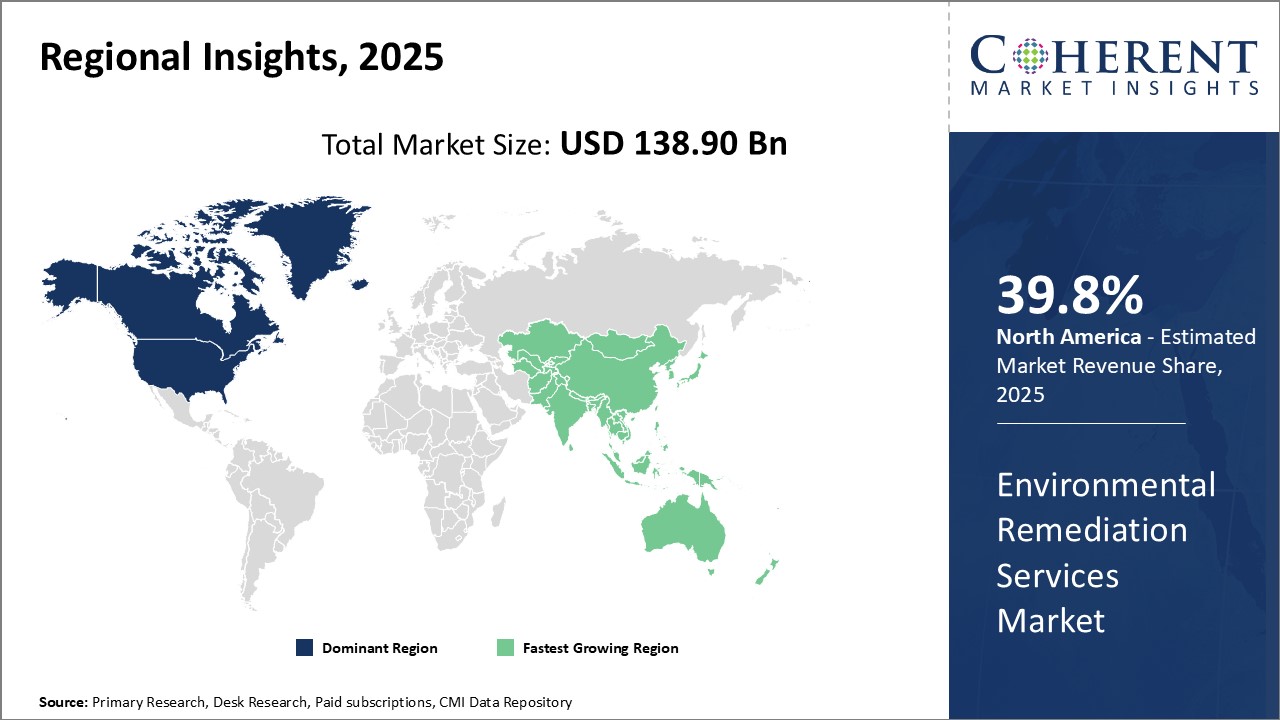The environmental remediation services market is estimated to be valued at USD 138.90 Billion in 2025 and is expected to reach USD 238.21 Billion by 2032, growing at a compound annual growth rate (CAGR) of 8.0% from 2025 to 2032.

Discover market dynamics shaping the industry: Request sample copy
Stringent government regulations regarding the treatment and disposal of solid and hazardous waste along with growing industrial activities are driving significant demand in the market. The market is expected to grow steadily over the next few years. Growing industrialization and urbanization have increased pollution levels globally. Furthermore, mounting public awareness about health issues owing to soil and water contamination is compelling government agencies and industrial players to increasingly outsource environmental remediation services. Various factors such as rising industrial activity, population growth, and fossil fuel consumption are also likely to increase the need for environmental remediation in the coming years.
Stringent Environmental Regulations
With growing concerns around climate change and environmental degradation, governments across the world are implementing stringent regulations to curb pollution and reduce carbon emissions. Environmental remediation aims to remove or neutralize pollutants and contaminants from air, water, or soil in order to protect public health and the environment. Various agencies like EPA in the U.S. have formulated rules and standards around permissible limits of pollutants released from industrial facilities and transportation sector. Non-compliance could entail heavy penalties, forcing companies to systematically audit their operations and overhaul outdated infrastructure and machinery. This has led to rising demand for specialized environmental consulting and testing services to help organizations evaluate the extent of contamination, develop remediation roadmaps and get requisite clearances. Furthermore, policies around waste management and disposal of hazardous substances are getting stricter with landfill bans on certain chemicals. Environmental remediation players are helping industries scientifically dispose hard-to-handle waste in an eco-friendly way through modern treatment and disposal technologies.
For instance, according to a statistical report published in August 2022 by Eurostat which is the is the statistical office of the European Union, industrial production in the EU increased by 8% in 2021 compared to 2020, with the value of sales for industrial production reaching US$5,429.08 billion (€5 209 billion), up by nearly 14% from US$477.45 billion (€4 581 billion) in 2020. Therefore, the rapid growth in industrialization will drive the environmental remediation market growth.

Get actionable strategies to beat competition: Request sample copy
Legacy Contamination Clean-up Projects
Another key growth driver for the environmental remediation market is the large number of legacy contamination clean-up projects underway. Past industrial activities and lack of environmental regulations had resulted in the widespread pollution of soil and groundwater resources at numerous locations. With enhanced scrutiny and community pressure, authorities are actively investigating and rehabilitating such contaminated sites. For example, in the U.S., programs like Superfund are focusing on remediation of abandoned hazardous waste sites which pose major health risks. Similarly, many developed nations in Europe have initiated brownfield redevelopment initiatives to convert abandoned industrial lands into usable real estate. Environmental consultants play a vital role in these extensive clean-up undertakings by conducting scientific assessments, outlining remediation strategies and seeing projects through to certification. Governments are allocating bigger budgets towards tackling legacy pollution issues. Large-scale remediation contracts provide continuous revenue streams for specialized service providers. Additionally, rising consciousness around tank cleaning, asbestos removal, and managing closed landfill sites has opened new growth avenues.
For instance, in March 2021, AECOM introduced its first large-scale field demonstration of DE-FLUORO, a pioneering treatment technology that economically and environmentally sustainably eliminates Per- and Polyfluoroalkyl Substances (PFAS) from contaminated liquids without generating hazardous waste.
Key Takeaways of Analyst:
The environmental remediation services market will experience steady growth over the forecast period driven by strict environmental protection regulations around the world. Growing industrialization and urbanization has led to increased pollution levels which is prompting governments to implement more stringent pollution laws and standards. The oil and gas industry in particular will boost market demand as aging infrastructure requires extensive remediation work for environmental compliance. However, market growth could be restrained by the high costs associated with remediation projects especially complex contamination clean-ups.
North America currently dominates the market owing to high environmental protection budgets and a large number of contaminated sites from industrial wastewater discharge and improper waste disposal practices in the past. Government mandates to clean up these legacy polluted sites will sustain demand. Europe is another major regional market supported by the region's eco-friendly initiatives. Developing nations are also contributing more to global spending as their awareness towards the importance of environmental stewardship rises.
Within the waste segment, soil and groundwater remediation generates the highest revenue the market over the next five years with in-situ and ex-situ treatment technologies. The in-situ remediation technique is anticipated to be the fastest growing segment because it prevents environmental disturbance and has relatively lower costs as compared to ex-situ methods.
Market Challenges: Balancing Stringent Regulations with Cost Pressures
Environmental remediation services are struggling to balance effective cleanup with financial constraints. Stringent regulations drive up compliance costs, squeezing profit margins. Additionally, unexpected site conditions during projects lead to budget overruns. Developing innovative solutions to address these challenges requires substantial investment in research and development. Unfortunately, the one-time and unpredictable nature of revenue streams for contaminated site cleanup makes long-term financial planning difficult.
Market Opportunities: Rising Demand Driven by Environmental Concerns and Regulations
Growing concerns about environmental pollution and stricter emission standards have increased the demand for the remediation of hazardous waste sites. Favorable government initiatives and spending on environmental protection in many nations are driving more project works. Emerging contaminants and expansion of remediation activities into new application areas also provide avenues for service providers to diversify their service offerings.

Discover high revenue pocket segments and roadmap to it: Request sample copy
In Situ Solutions Dominate the Service Type Segment
In situ is expected to contribute the highest share of 54.7% in 2025, due to its advantages over ex situ methods. In situ technology involves treating contaminated soil and groundwater directly in place without excavating or removing it. This minimizes disruption to the land and avoids costly transportation and disposal issues associated with digging up and hauling away contaminated material. In situ methods are often the most cost-effective and practical solution for large, complex sites with widespread low-level contamination deep underground.
A key driver is the ability to remediate hard-to-access contamination. In situ techniques like chemical oxidation, biological remediation, and thermal desorption can reach contamination in low-permeability zones and locations under buildings or other structures that cannot be physically excavated. This expands the potential customer base to include heavily developed urban and industrial sites that would be impossible to fully remediate using ex situ methods. Government regulations increasingly favor leaving contamination in place and treating it versus costly removal and off-site disposal.
Additionally, in situ techniques cause less environmental disturbance during remediation. They do not require large excavations, heavy earth-moving equipment, traffic from hauling waste, or disturbed soil piles. This reduces emissions, dust, noise levels, and risk of cross-contamination at remediation projects. For customers in sensitive coastal or wildlife areas, in situ avoids aquatic and habitat disruptions that open-cut soil removal would entail. Its minimal surface footprint helps remediation qualify for "green cleanup" certifications and expedited permits.
Oil and Gas Generates the Strongest Demand in the Application Segment
The oil and gas segment is expected to generate the strongest demand within application segment with a market share of 34.09% in 2025. Extensive historical and ongoing operations at oil and gas sites have left a considerable legacy of soil and groundwater contamination from spills, leaks, and improper waste disposal. Stringent regulations now require full investigation and remediation of contamination at active and retired facilities. This generates substantial long-term work cleaning up former drill sites, pipelines, refineries, storage tanks, and other infrastructure. Remediation is a necessary cost for property transfers, facility upgrades, and closure/repurposing of aged assets.
Additionally, as unconventional drilling spreads to more locations, remediation is increasingly needed for associated issues. Accidents can release drilling fluids, produce water, or hydrocarbons into the environment. Improper well construction or cementing sometimes allows the migration of hydrocarbons into shallow groundwater. As with conventional oil and gas, regulatory compliance now mandates assessment and cleanup of any resultant soil and water contamination from shale, oil sands and other unconventional operations.
Oil and gas also drives demand due to large-scale planned remediation programs. Major companies now proactively remediate historically contaminated properties to sustainability goals or eliminate long-term liabilities. Government stimulus progressively funds environmental cleanup of orphans sites without a responsible owner. Such projects provide reliable work for environmental service providers.
For instance, in March 2021, AECOM a infrastructure consulting firm, launched DE-FLUORO, a cost-effective and environmentally friendly treatment technology for removing per and polyfluoroalkyl substances (PFAS) from contaminated liquids without producing hazardous waste.

Need a Different Region or Segment? Customize now
North America has established itself as the dominant region in the global environmental remediation services market. The region is expected to account for a market share of 39.8% in 2025. The region is home to many industry-leading players who have developed comprehensive service offerings to address the varied environmental remediation needs across sectors. Stringent regulatory norms regarding pollution control and waste management have propelled the early adoption of remediation services in the region. Large brownfield sites, heavy industrial activity, and growing awareness about sustainability have also contributed to the sizeable market presence. The region also has a well-established hazardous waste treatment infrastructure that encourages the entire remediation value chain.
Asia Pacific is poised to become the fastest growing regional market with a CAGR of 12.21% in 2025. Rapid industrialization and urbanization have elevated pollution levels in many developing nations. This has galvanized regulatory authorities to enforce environmental protection mandates more vigorously. At the same time, companies across industries are realizing the importance of restoring contaminated land and water bodies to pre-disposal conditions for maintaining their social license to operate. While being in a growth stage currently, Asian countries are acknowledging remediation as a critical tool for sustainable development. Their proactive policies and investments are expected to stimulate higher service uptake going forward.
Within the Asia Pacific region, India in particular stands out for its future market potential. Bolstering manufacturing activity combined with lax historical adherence to norms has led to massive pollution loads. The government's recent focus on environmental stewardship through regulatory tightening and reforms offers a large addressable opportunity for service providers. The availability of low-cost skilled labor and a price-sensitive clientele make India an attractive remediation outsourcing hub as well. Meanwhile, Indian conglomerates are displaying a growing commitment to invest in remediation projects across their facilities and subsidiaries. These factors indicate India will experience exceptionally strong growth compared to other developing Asian countries.
Environmental Remediation Services Market Report Coverage
| Report Coverage | Details | ||
|---|---|---|---|
| Base Year: | 2024 | Market Size in 2025: | USD 138.90 Bn |
| Historical Data for: | 2020 To 2024 | Forecast Period: | 2025 To 2032 |
| Forecast Period 2025 to 2032 CAGR: | 8.0% | 2032 Value Projection: | USD 238.21 Bn |
| Geographies covered: |
|
||
| Segments covered: |
|
||
| Companies covered: |
O6 ENVIRONMENTAL SERVICES., AECOM, Ambleside Environmental, Amentum Services Inc., Bechtel Corporation, Black & Veatch Holding Company, Brisea Group Inc., Clean Management Environmental Group, Inc., DEME NV, Dredging Corporation of India Ltd, Engineering and Maintenance Solutions (EMS), ENVIRONMENTAL WORKS, INC., Environmental Remediation Services, Inc., Fluor Corporation, GEO Inc., Golder Associates Corporation, Haz Mat Special Services, LLC, HEPACO, In-Situ Oxidative Technologies Inc., MICROBIAL INSIGHTS, NewTerra Ltd., NorthStar Group Services Inc., Sequoia Environmental remediation Inc., Sprint Sanierung GmbH, Terra Systems Inc., Triumvirate Environmental, USES CORPORATION, and Weber Ambiental |
||
| Growth Drivers: |
|
||
| Restraints & Challenges: |
|
||
Uncover macros and micros vetted on 75+ parameters: Get instant access to report
*Definition: The environmental remediation services market involves companies that provide consulting, removal, containment, and disposal services for hazardous materials and waste at contaminated properties such as industrial sites, landfills, and mining locations. They assess damaged environments, design and manage remediation projects to clean polluted media like soil, surface water and groundwater.
Share
Share
About Author
As an accomplished Senior Consultant with 7+ years of experience, Pooja Tayade has a proven track record in devising and implementing data and strategy consulting across various industries. She specializes in market research, competitive analysis, primary insights, and market estimation. She excels in strategic advisory, delivering data-driven insights to help clients navigate market complexities, optimize entry strategies, and achieve sustainable growth.
Missing comfort of reading report in your local language? Find your preferred language :
Transform your Strategy with Exclusive Trending Reports :
Frequently Asked Questions
Joining thousands of companies around the world committed to making the Excellent Business Solutions.
View All Our Clients
US Reciprocal Tax Impact Analysis On Environmental Remediation Services Market
Stay updated on tariff changes with expert insights and timely information